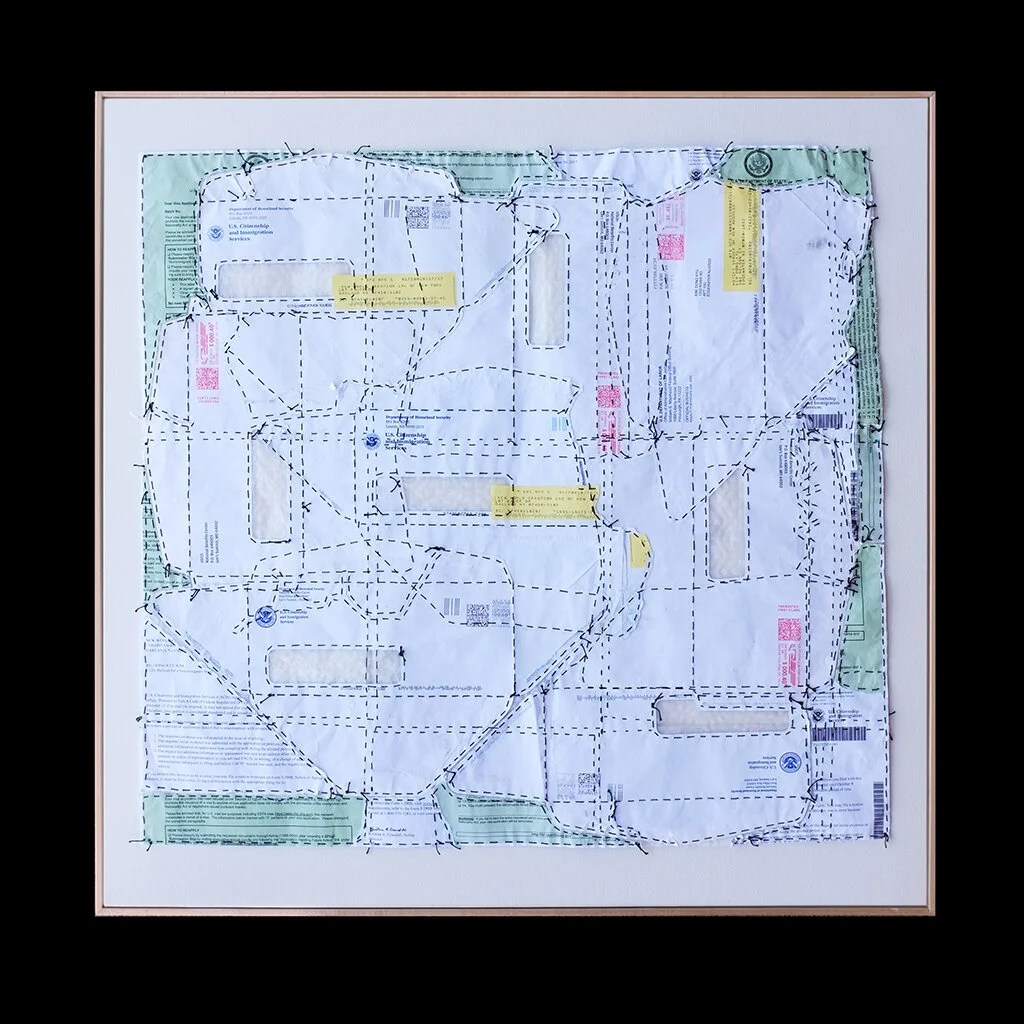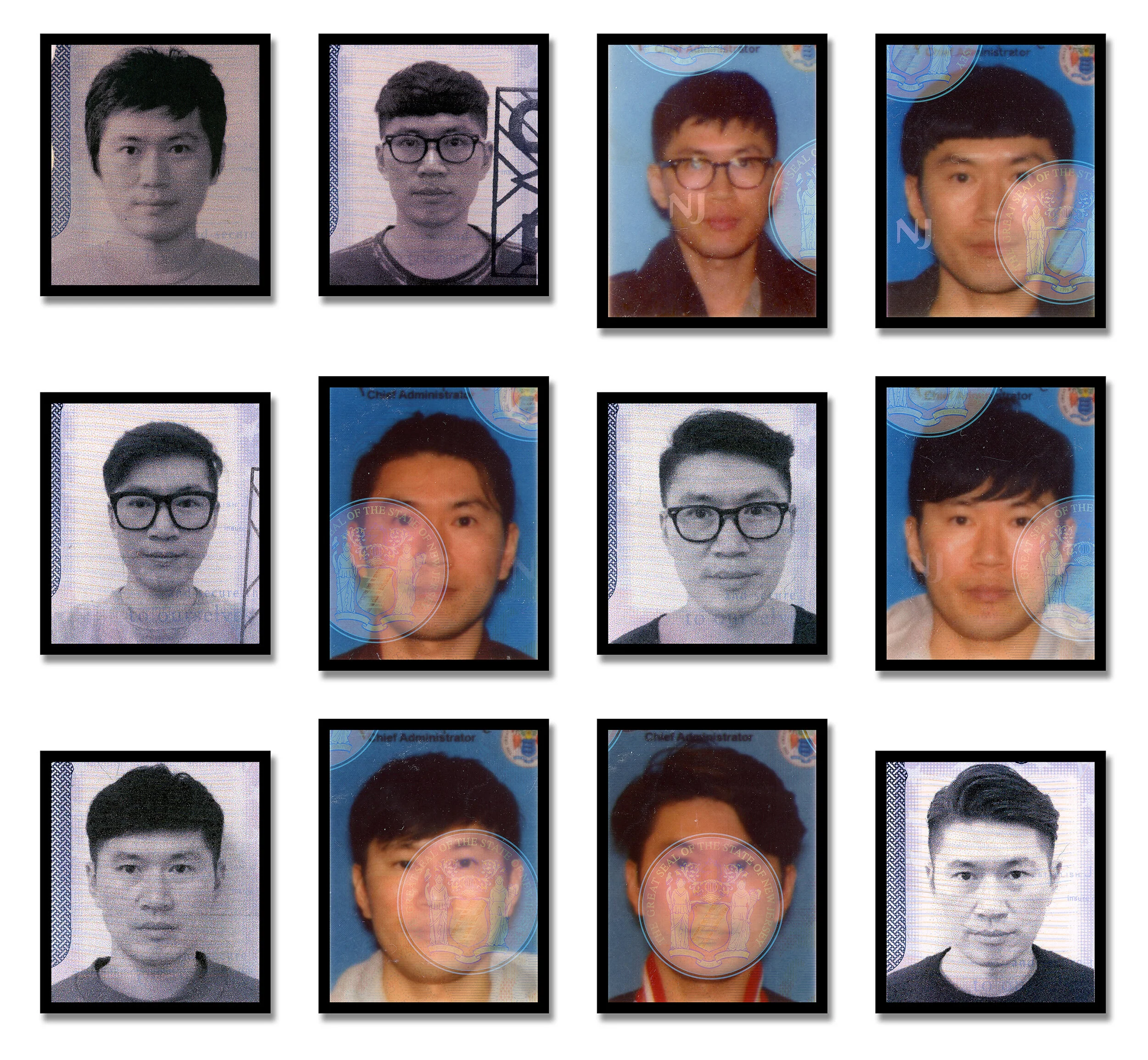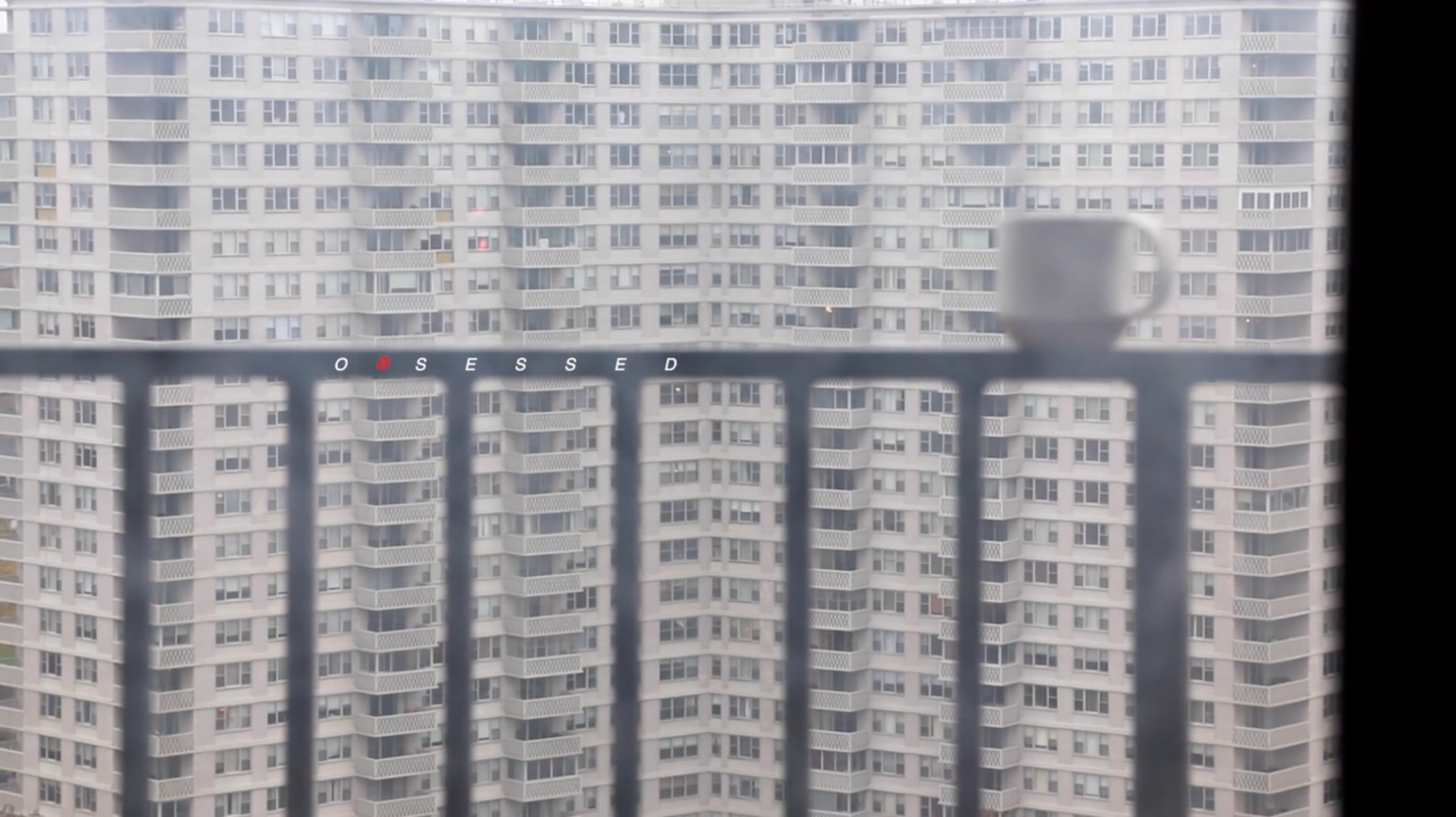Dong Kyu Kim is a mixed-media artist and fashion designer whose works are constructed of paper receipts, tickets, and other materials collected over the past 14 years since relocating to the United States. All his materials are sewn together by hand. Kim’s work explores his relationship to the U.S., the concept of the American dream, and how individual lives are affected by transitions in global economic structures.
Kim has exhibited in museums and galleries throughout the U.S. He recently received a 2021 New Jersey Individual Artist Fellowship Award from the New Jersey State Council on the Arts and his work has received awards from many institutions, including the Florida State University Museum of Arts, FL; Oklahoma State University, OK; Minot State University, ND; and many others. He received a Bachelor of Fine Arts Degree in Fashion Design.
His work is the subject of future solo exhibitions at The Delaplaine Arts Center in Maryland (2021); Minot State University in North Dakota (2022); and Marist College in New York (not yet scheduled).
For more information, please see: www.dongkyu-kim.com, and on Instagram @the_sewing_man.
Dong Kyu Kim, The United Stitches, 2017. 63” (H) X 55” (W). Receipts, threads, tickets, microfiber cloths. Image courtesy of the artist.
The United Stitches is composed of 307 individual receipts collected between 2014 and 2016 mostly in Fort Lee (NJ), New York City and their vicinity, it also includes pieces from Los Angeles, Miami, Hawaii, Key West, Philadelphia and Boston.
Dong Kyu Kim’s collection of paper receipts. Image by Colleen Gutwein.
First, and most importantly, how are you doing? How are you navigating the highs and lows?
I’m doing great. I’m even trying to enjoy this tranquil time. As a full-time fashion designer, I have been juggling my job and my art for several years. I used to spend time on my art every night after work and every weekend. I pushed myself very hard, probably too hard, and I ended up with a lot of stress. The long and challenging process of trying to get my green card for over a decade also contributed to feelings of anxiousness. Thankfully, I finally got my green card in November 2019.
I tried to slow down right before the pandemic hit but my exhibition schedule didn’t let me. I had a solo exhibition at Concordia University in Ann Arbor in February 2020. My show at the Delaplaine Art Center in May to June 2020 was held as both a physical and virtual exhibition in May and June of 2020. My third exhibition in 2020, Everything Must Go, at Marist College was planned for September but was cancelled due to the pandemic. For the first time, I was very disappointed to lose a chance to show to the public because I put so much effort (time and money!) into the project over the course of a year. But, I quickly realized that this break would be a great opportunity to think more deeply about my work and would give me additional time to prepare for future exhibits. The pandemic has given me time to take care of myself, appreciate nature, and get some perspective on what’s important to me.
Dong Kyu Kim, Officially Void, 2019. 31” (H) X 31” (W). Original paper envelopes and letters from U.S. Citizenship and Immigration Services, threads and microfiber cloths. Image courtesy of the artist.
Officially Void is composed of immigration papers torn apart and sewn back together, evidence of my struggle to obtain a green card. This work explores my relationship to the United States and the concept of the American dream.
Dong Kyu Kim, Officially Void (detail), 2019. 31” (H) X 31” (W). Original paper envelopes and letters from U.S. Citizenship and Immigration Services, threads and microfiber cloths. Image courtesy of the artist.
Officially Void is composed of immigration papers torn apart and sewn back together, evidence of my struggle to obtain a green card. This work explores my relationship to the United States and the concept of the American dream.
It's my experience that most artists engage with some level of self-isolation in their day to day art practice. Has this been your experience? And if so, have you found these innate rhythms to be helpful during this larger, world-wide experience of isolation?
I moved to the U.S. in 2007 and have lived alone since then. I don’t have any family here. I have Korean friends, but few connections in the American community. I know that isolation is often inevitable for immigrants, but it’s also suited to my personality.
For three years (from 2017-2019), I was singularly focused on my art, which meant that I spent most of my time by myself in my studio apartment (also my work studio!), which is chock full of materials I've saved over the past decade. My competitive nature forced me to continually apply to open calls for my artwork. While it wasn’t healthy for me in many respects, I’m glad that I am now being recognized by the American art community. Eventually, the pandemic required me to slow down and, ironically, this is when I started to reconnect to family and friends again. I know the pandemic has been terribly difficult for many people, so I feel a little guilty saying that it has offered me some inner peace.
Dong Kyu Kim, Colonialism Isn't Dead Yet, 2020. 55” (H) X 46” (W). Brown paper shopping bags, packing tape, Swiffer microfiber. Image courtesy of the artist.
Colonialism Isn't Dead Yet is a mixed media collage of brown paper shopping bags and packing tape. The pieces are sewn together by hand with crisscrossed stitches using various colors of thread. Multiple layers of thread create geometric patterns of so-called Burberry checks across the artwork.
Dong Kyu Kim, Colonialism Isn't Dead Yet (detail), 2020. 55” (H) X 46” (W). Brown paper shopping bags, packing tape, Swiffer microfiber. Image courtesy of the artist.
Colonialism Isn't Dead Yet is a mixed media collage of brown paper shopping bags and packing tape. The pieces are sewn together by hand with crisscrossed stitches using various colors of thread. Multiple layers of thread create geometric patterns of so-called Burberry checks across the artwork.
It would be great if you could briefly talk us through your practice. Understanding it is integral to appreciating the multivalence of your work.
My artistic practice is to experiment, observe, and record the process of how consumer habits acquire value in this era of neoliberalism.
For example, my upcoming exhibition (not yet scheduled), Everything Must Go, is comprised of individual items purchased weekly over the course of 17 months (from February 2018 to July 2019) from the Supreme boutique in New York City’s SoHo neighborhood. The series contains works assembled from receipts, promotional stickers, vinyl shopping bags, and other artifacts of the shopping experience.
The act of revisiting the same location every week for an extended period to make a purchase is a tribute to everyday, commonplace activities and objects.
For me, the Supreme brand epitomizes the current state of the fashion market. After 40 years of neoliberalism, the fashion market eventually saw the decline of low-priced, mass-produced goods with the 2008 financial crisis—making way for a new but as yet undefined successor ideology. Since then, I have seen fashion retail adopting the methodologies and strategies of the art market, such as creating value through deliberate and controlled production. Value is now generated through limited editions and distribution, brand collaborations, and the resale market. The Supreme products in this exhibition reflect this value phenomenon: their limited production and high prices create value in the minds of buyers, dealers, and sellers.
As a fashion designer for 20 years, I have always been interested in the intersection of fashion and art. I see the boundaries between the two continue to blur.
Dong Kyu Kim, Shape of You (Front & Back View), 2020. 70” (H) X 48” (W). Paper receipts, threads, microfiber cloths, American flag. Image courtesy of the artist.
Shape of You is composed of paper receipts and promotional stickers acquired from the Supreme store in New York City over the course of a year, hand-stitched onto a t-shirt using thread and Swiffer material. The extra-large American flag is stitched to the back of the t-shirt.
Has any of your imagery shifted in a reflection to what's currently happening? And why, or why not?
My art reflects my consumer habits, so changes in the current retail market are significant to me. Typically, I spend money at actual stores and get paper receipts. It’s like performance art. The receipts are records of my activities and experience. But the pandemic has forced consumers to shop online and receive digital receipts. The retail industry had been transforming from brick and mortar to online before the pandemic but the trend has now accelerated. In general, shopping activity is going online and that means human activities and memories also go online and into virtual reality. My art is definitely impacted by such transitions in global economic structures. I’m really curious to see whether the trend will continue when the pandemic is over.
Dong Kyu Kim, The Most Famous Stripes #2, 2020. 131” (H) X 19” (W). Elastic waist band, cotton, thread. Image courtesy of the artist.
The Most Famous Stripes #2 comprises elastic waistbands and white cotton fabric from men’s underwear purchased at the Supreme store in New York City. The cotton fabric and the waistbands, which feature the red Supreme logo, have been hand-stitched together.
Dong Kyu Kim, The Most Famous Stripes #2 (detail), 2020. 131” (H) X 19” (W). Elastic waist band, cotton, thread. Image courtesy of the artist.
The Most Famous Stripes #2 comprises elastic waistbands and white cotton fabric from men’s underwear purchased at the Supreme store in New York City. The cotton fabric and the waistbands, which feature the red Supreme logo, have been hand-stitched together.
Are you thinking differently? Coping differently? Inspired differently?
The pandemic really hasn’t changed my daily routine. My company, a wholesaler for urban young men, is trying to invest in the retail business, but my own work as a fashion designer hasn’t changed. In my art, however, I've been expanding my medium. Before the pandemic, I primarily used my paper receipts but now I create videos and site-specific installations. For example, for my future solo exhibition at The Delaplaine Arts Center, I will show works composed letters and documents from the U.S. Citizenship and Immigration Services, as well as self-portrait photos from my expired U.S. H1B visas and New Jersey driver’s licenses.
Dong Kyu Kim, Temporarily Qualified (2007-2019), 2019. 23 1/2” (H) X 25 1/2” (W). Inkjet print. Image courtesy of the artist.
Temporarily Qualified (2007-2019) is a group of photographs from my expired United States H1B visas and New Jersey driver’s licenses. The images span from 2007 to 2019, when I was living in the U.S. as a temporary immigrant worker before obtaining a green card in November 2019.
Dong Kyu Kim, Temporarily Qualified (2007-2019) (detail), 2019. 23 1/2” (H) X 25 1/2” (W). Inkjet print. Image courtesy of the artist.
Temporarily Qualified (2007-2019) is a group of photographs from my expired United States H1B visas and New Jersey driver’s licenses. The images span from 2007 to 2019, when I was living in the U.S. as a temporary immigrant worker before obtaining a green card in November 2019.
What is bringing you solace, or even joy, in this moment?
My massage gun! I bought this last Thanksgiving and I can’t live without it. It helps me relax and keeps my metabolism on track. But, seriously, I am finding a lot of joy in reaching people like you through my art.
View from my 4th solo exhibition, ‘The Stranger in Heaven’ at Kreft Center Gallery, Concordia University Ann Arbor, MI, January 28 – February 23, 2020 right before Pandemic. Image by Kelly Cieslak.
What research or writing are you doing that you find compelling?
I am always researching ways in which economic structures influence people’s lives—and especially the impacts of neoliberalism and globalization. As someone who grew up in South Korea during the 1980s and 1990s, I want to understand where my own strong motivation to work and live in the U.S. came from.
Film stills from Obsessed, directed by Elizabeth Clark.
Kim and Clark met each other in the Immigrant Artist Mentoring Program (Newark, NJ) created by the New York Foundation for the Arts in 2017, and created this short film during the pandemic, November 2020.
Are you reading anything?
Your blog! Social Distancing Studio Visit! It’s been a great pleasure to read other artists’ interviews. I already know some of them and I am discovering others. Reading what other artists have to say about themselves and their own trajectories is inspiring, especially to an immigrant like me who has struggled to connect to the art community here.
And I’m addicted to Instagram. There is so much information to digest and I don’t want to miss anything!
Film stills from Obsessed, directed by Elizabeth Clark.
Kim and Clark met each other in the Immigrant Artist Mentoring Program (Newark, NJ) created by the New York Foundation for the Arts in 2017, and created this short film during the pandemic, November 2020.














